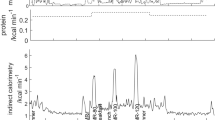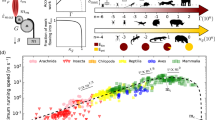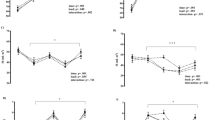Abstract
When travelling in East Africa one is often surprised at the prodigious loads carried by the women of the area. It is not uncommon to see women of the Luo tribe carrying loads equivalent to 70% of their body mass balanced on the top of their heads (Fig. 1). Women of the Kikuyu tribe carry equally large loads supported by a strap across their foreheads; this frequently results in a permanently grooved skull. Recent experiments on running horses, humans, dogs and rats showed that the energy expended in carrying a load increased in direct proportion to the weight of the load for each animal at each speed, that is, carrying a load equal to 20% of body weight increased the rate of energy consumption by 20% (ref. 1). The purpose of the present study was to determine whether these African women use specialized mechanisms for carrying very large loads cheaply. We found that both the Luo and Kikuyu women could carry loads of up to 20% of their body weight without increasing their rate of energy consumption. For heavier loads there was a proportional increase in energy consumption, that is, a 30% load increased energy consumption by 10%, a 40% load by 20% and so on. We suggest that some element of training and/or anatomical change since childhood may allow these women to carry heavy loads economically.
This is a preview of subscription content, access via your institution
Access options
Subscribe to this journal
Receive 51 print issues and online access
$199.00 per year
only $3.90 per issue
Buy this article
- Purchase on Springer Link
- Instant access to full article PDF
Prices may be subject to local taxes which are calculated during checkout
Similar content being viewed by others
References
Taylor, C.R., Heglund, N.C., McMahon, T.A. & Looney, T.R. J. exp. Biol. 86, 9–18 (1980).
Fedak, M. A., Rome, L. & Seeherman, H. J. J. appl. Physiol. 51(3), 772–776 (1981).
Margaria, R. Biomechanics and Energetics of Muscular Exercise (Clarendon, Oxford, 1976).
Pandolf, K. B., Givoni, B. & Goldman, R. F. J. appl. Physiol. 43(4), 577–581 (1977).
Hoyt, D. F. & Taylor, C. R. Nature 292, 239–240 (1981).
Cavagna, G. A., Thys, H. & Zamboni, A. J. Physiol, Lond. 262, 639–657 (1976).
Cavagna, G. A., Saibene, F. P. & Margaria, R. J. appl. Physiol. 19(2), 249–256 (1964)
Author information
Authors and Affiliations
Rights and permissions
About this article
Cite this article
Maloiy, G., Heglund, N., Prager, L. et al. Energetic cost of carrying loads: have African women discovered an economic way?. Nature 319, 668–669 (1986). https://doi.org/10.1038/319668a0
Received:
Accepted:
Issue Date:
DOI: https://doi.org/10.1038/319668a0
This article is cited by
-
A review of the design of load-carrying exoskeletons
Science China Technological Sciences (2022)
-
Hunters Who Haul with Dogs: Man’s Best-Friend or Woman’s Little Helper?
Human Ecology (2021)
-
Measuring the Energy of Ventilation and Circulation during Human Walking using Induced Hypoxia
Scientific Reports (2017)
-
Standing economy: does the heterogeneity in the energy cost of posture maintenance reside in differential patterns of spontaneous weight-shifting?
European Journal of Applied Physiology (2017)
-
Clinical Relevance of Fascial Tissue and Dysfunctions
Current Pain and Headache Reports (2014)
Comments
By submitting a comment you agree to abide by our Terms and Community Guidelines. If you find something abusive or that does not comply with our terms or guidelines please flag it as inappropriate.



